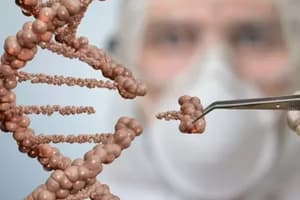Podcast
Questions and Answers
What staining method is used to obtain Q-banding in chromosomes?
What staining method is used to obtain Q-banding in chromosomes?
- Quinacrine stain (correct)
- Hematoxylin stain
- Giemsa stain
- Trypsin digestion
Which type of bands are obtained when chromosomes are stained with Giemsa after trypsin digestion?
Which type of bands are obtained when chromosomes are stained with Giemsa after trypsin digestion?
- Beta bands
- Alpha bands
- Centromeric bands
- Light and dark bands (correct)
What is the main characteristic of R-bands on chromosomes?
What is the main characteristic of R-bands on chromosomes?
- Stain centromeres
- Lightly stained regions
- Guanine-cytosine-rich regions (correct)
- Rich in adenine-thymine base pairs
Which type of staining binds to constitutive heterochromatin in chromosomes?
Which type of staining binds to constitutive heterochromatin in chromosomes?
What is the function of T-banding in chromosome visualization?
What is the function of T-banding in chromosome visualization?
What was the purpose of the classification proposed at the conference in Denver (1960) regarding chromosomes?
What was the purpose of the classification proposed at the conference in Denver (1960) regarding chromosomes?
Which banding technique involves gentle trypsin treatment of chromosomes followed by staining with Giemsa?
Which banding technique involves gentle trypsin treatment of chromosomes followed by staining with Giemsa?
Who introduced the first banding technique for chromosomes using quinacrine and obtained Q-bands?
Who introduced the first banding technique for chromosomes using quinacrine and obtained Q-bands?
Which banding technique was introduced at the Paris Conference in 1971 to identify individual chromosomes?
Which banding technique was introduced at the Paris Conference in 1971 to identify individual chromosomes?
What is the position of G-bands primarily rich in?
What is the position of G-bands primarily rich in?
How is each chromosome arm initially divided for the identification of bands in G-banding?
How is each chromosome arm initially divided for the identification of bands in G-banding?
Which banding technique resulted in the production of the first human banded chromosomes by using quinacrine?
Which banding technique resulted in the production of the first human banded chromosomes by using quinacrine?
In a male somatic cell, how many total chromosomes are present?
In a male somatic cell, how many total chromosomes are present?
What is the term for chromosomes classified based on the position of their centromere?
What is the term for chromosomes classified based on the position of their centromere?
Which arm of a chromosome is referred to as the 'p arm'?
Which arm of a chromosome is referred to as the 'p arm'?
What is the primary criteria used for arranging chromosomes in order?
What is the primary criteria used for arranging chromosomes in order?
Which type of chromosome has a centromere positioned at one end resulting in a very small short arm?
Which type of chromosome has a centromere positioned at one end resulting in a very small short arm?
What characterizes chromosomes with a secondary constriction containing genes for organizing the nucleolus?
What characterizes chromosomes with a secondary constriction containing genes for organizing the nucleolus?
What is the correct term for human somatic cells containing two sets of chromosomes?
What is the correct term for human somatic cells containing two sets of chromosomes?
How many pairs of homologous chromosomes are present in human somatic cells?
How many pairs of homologous chromosomes are present in human somatic cells?
Which scientist introduced the term 'chromosome' derived from Greek words for 'colour' and 'body'?
Which scientist introduced the term 'chromosome' derived from Greek words for 'colour' and 'body'?
What is the correct chromosome number in human somatic cells as determined by Tjio and Levan in 1956?
What is the correct chromosome number in human somatic cells as determined by Tjio and Levan in 1956?
How many pairs of autosomes are present in male human somatic cells?
How many pairs of autosomes are present in male human somatic cells?
Which type of cells contain one set of chromosomes?
Which type of cells contain one set of chromosomes?
Flashcards are hidden until you start studying
Study Notes
Chromosome Banding Techniques
- Q-banding in chromosomes is obtained using quinacrine staining method.
- G-bands are obtained when chromosomes are stained with Giemsa after trypsin digestion.
- R-bands on chromosomes are characterized by being rich in GC bases and have a reverse pattern compared to G-bands.
Types of Bands and Staining
- C-banding is a staining technique that binds to constitutive heterochromatin in chromosomes.
- T-banding is a technique used for chromosome visualization, especially for telomeres.
History of Chromosome Classification
- The Denver Conference in 1960 introduced a classification system for chromosomes.
- The Paris Conference in 1971 introduced a banding technique to identify individual chromosomes.
Chromosome Structure and Characteristics
- G-bands are primarily rich in AT bases and are found in the heterochromatic regions of chromosomes.
- Each chromosome arm is initially divided into regions, then bands, for identification in G-banding.
- Acrocentric chromosomes have a centromere positioned at one end, resulting in a very small short arm.
- Chromosomes with a secondary constriction containing genes for organizing the nucleolus are characterized by nucleolar organizing regions (NORs).
Cell Biology and Chromosome Number
- A male somatic cell contains 46 total chromosomes.
- Diploid cells, like human somatic cells, contain two sets of chromosomes.
- There are 23 pairs of homologous chromosomes in human somatic cells.
History of Chromosome Research
- The term 'chromosome' was introduced by Heinrich Wilhelm Gottfried von Waldeyer-Hartz, derived from Greek words for 'colour' and 'body'.
- The correct chromosome number in human somatic cells is 46, as determined by Tjio and Levan in 1956.
- Male human somatic cells contain 22 pairs of autosomes.
Studying That Suits You
Use AI to generate personalized quizzes and flashcards to suit your learning preferences.




